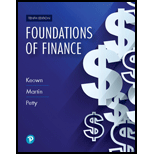
EBK FOUNDATIONS OF FINANCE
10th Edition
ISBN: 9780135160473
Author: KEOWN
Publisher: PEARSON CO
expand_more
expand_more
format_list_bulleted
Concept explainers
Question
Chapter 4, Problem 5SP
Summary Introduction
To determine: Additional short term funding.
Expert Solution & Answer
Want to see the full answer?
Check out a sample textbook solution
Students have asked these similar questions
Hii Please solve this question by using appropriate method.
need solhelp by real expert and true answer.
need help by real expert and corr answer.
Chapter 4 Solutions
EBK FOUNDATIONS OF FINANCE
Ch. 4 - Describe the five-question approach to using...Ch. 4 - What are the limitations of industry average...Ch. 4 - What is the difference between a firms gross...Ch. 4 - Prob. 9RQCh. 4 - Prob. 1SPCh. 4 - Prob. 2SPCh. 4 - Prob. 3SPCh. 4 - (Price/ book) Chang, Inc.s balance sheet shows a...Ch. 4 - Prob. 5SPCh. 4 - (Ratio analysis) The balance sheet and income...
Knowledge Booster
Learn more about
Need a deep-dive on the concept behind this application? Look no further. Learn more about this topic, finance and related others by exploring similar questions and additional content below.Similar questions
- Solve this qn with proper step.arrow_forwardif $500 is placed in an account that earns a normal 6 % compounded quarterly, what will be worith in 10 years. a. $907 b. $1,045 c. $980 d. $ 1,020 e. $117.48arrow_forwardwhat is the approximate yield to maturity (YTM) of a bond that is currently selling for $1,150 in the market place ? the annual bond has 20 years remaining until maturity and pays a 14% coupon. (assume annual interest payments and discounting) a. 14% b. 7% c. 6% d. 12%arrow_forward
- If blurr image please comment i will write values. please dont Solve with incorrect values otherwise unhelpful.arrow_forwardInferior Investment Alternatives Although investing requires the individual to bear risk, the risk can be controlled through the construction of diversified portfolios and by excluding any portfolio that offers an inferior return for a given amount of risk. While this concept seems obvious, one of your clients, Laura Spegele, is considering purchasing a stock that you believe will offer an inferior return for the risk she will bear. To convince her that the acquisition is not desirable, you want to demonstrate the trade-off between risk and return. While it is impractical to show the trade-off for all possible combinations, you believe that illustrating several combinations of risk and return and applying the same analysis to the specific investment should be persuasive in discouraging the purchase. Currently, U.S. Treasury bills offer 2.5 percent. Three possible stocks and their betas are as follows: 1. What will be the expected return and beta for each of the following portfolios? a.…arrow_forwardSolve this fin. Qn no aiarrow_forward
arrow_back_ios
SEE MORE QUESTIONS
arrow_forward_ios
Recommended textbooks for you
 EBK CONTEMPORARY FINANCIAL MANAGEMENTFinanceISBN:9781337514835Author:MOYERPublisher:CENGAGE LEARNING - CONSIGNMENT
EBK CONTEMPORARY FINANCIAL MANAGEMENTFinanceISBN:9781337514835Author:MOYERPublisher:CENGAGE LEARNING - CONSIGNMENT

EBK CONTEMPORARY FINANCIAL MANAGEMENT
Finance
ISBN:9781337514835
Author:MOYER
Publisher:CENGAGE LEARNING - CONSIGNMENT

